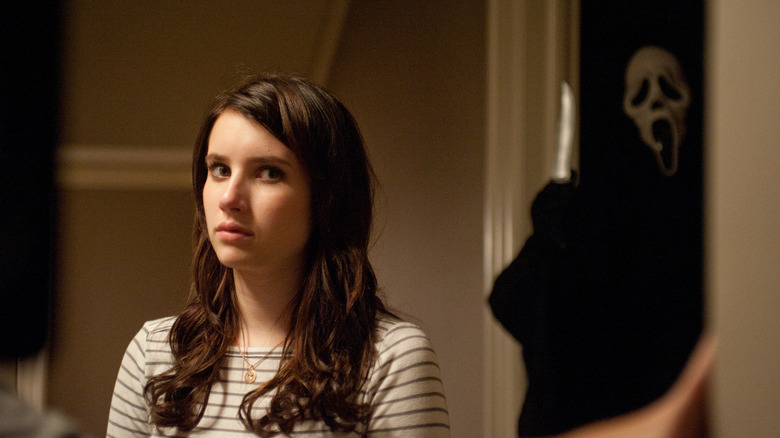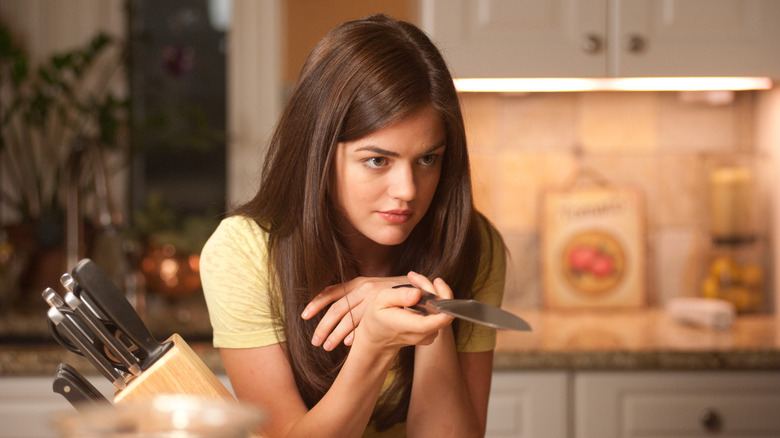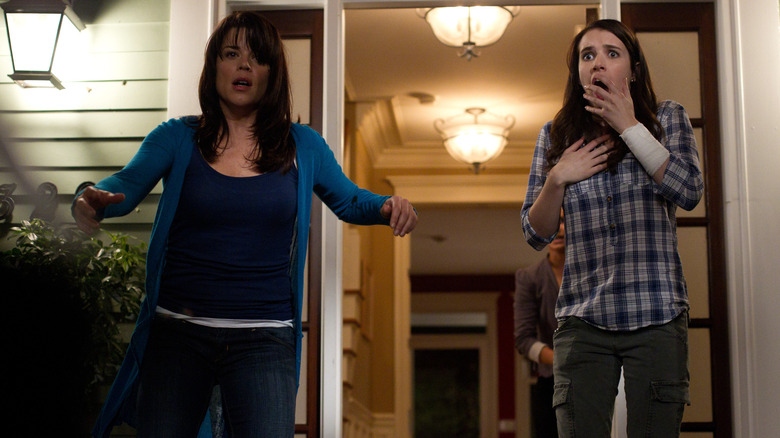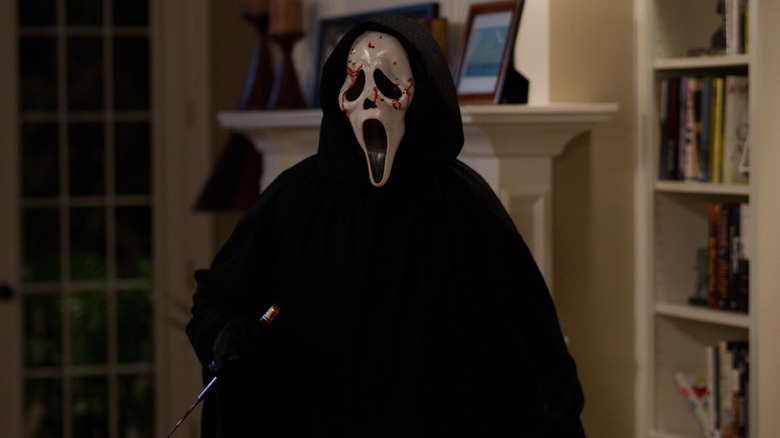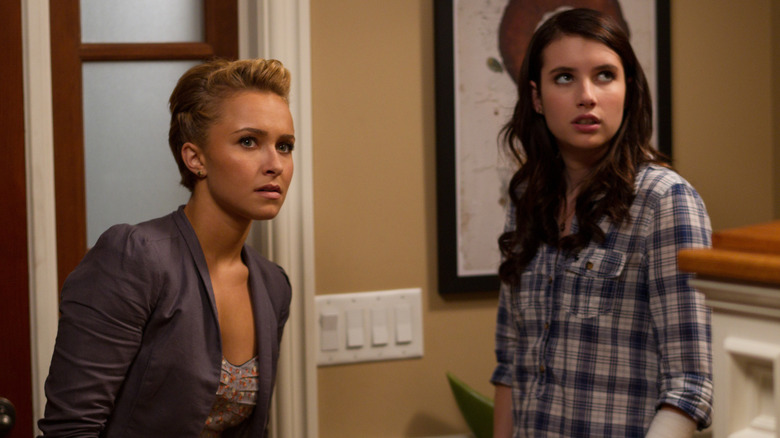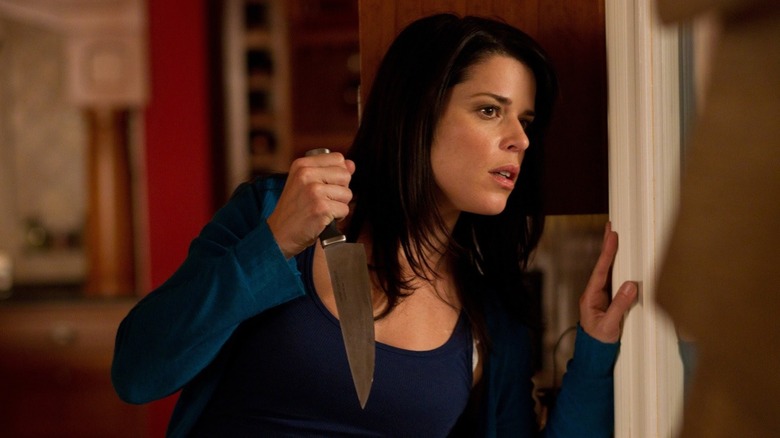Tales From The Box Office: Scream 4 Was Horror Master Wes Craven's Unintended Farewell
(Welcome to Tales from the Box Office, our column that examines box office miracles, disasters, and everything in between, as well as what we can learn from them.)
There are few names as synonymous with horror as Wes Craven's. This is the man who gifted us "A Nightmare on Elm Street," which gave us one of horror's all-time slasher villains in the form of Freddy Kreuger. He's also the man who, when it was all but dead, saved the slasher genre in remarkable fashion with the meta "Scream" in 1996. For as much as "Elm Street" was his calling card, it's easy to argue now that "Scream" is his greatest legacy. To that end, it's perhaps fitting that Craven's final movie (even if that wasn't the plan) was 2011's "Scream 4."
The original trilogy of "Scream" films were pumped out in rapid succession by Miramax, but following the release of "Scream 3" in 2000, the series took a very long break. As is pretty much the case with any horror franchise in Hollywood, the powers that be would only allow it to stay dead for so long. Enter "Scream 4," which came out more than a decade later at a time when franchise fever was swallowing up the horror genre, with "Saw" having dominated the box office from 2004 to 2010. But Craven had one last bit of commentary to offer horror fans before he said farewell in a movie that may just have been a touch ahead of its time.
In honor of the release of "Scream VI," we're looking back at "Scream 4," how it came to be, the somewhat messy production that Craven's final film turned into, its initial reception versus the re-evaluation that would come, and what lessons we can learn from it in the modern context. Let's dig in, shall we?
The movie: Scream 4
In the years after "Scream 3," Craven would go on to direct "Cursed," "Red Eye," and "My Soul to Take," as well as a segment in "Paris je t'aime," in addition to producing remakes of "The Hills Have Eyes" and "The Last House on the Left." The man managed to stay busy, to be certain. But fate would will it that the master of horror would return to arguably his most iconic franchise for his final film. "Scream 4" was officially confirmed to be happening in July of 2008, though Craven was not yet on board to direct. Eventually, he did agree to sign on come March 2010. It was off to the races in Woodsboro once again.
Kevin Williamson, who penned the original "Scream" as well as "Scream 2," returned once again to write the screenplay. Williamson explained well in advance of the movie's release that he wanted to tell a character-heavy story. More than that, he was looking to rebuke the horror of the moment, which had become very sequel-heavy, particularly the "Saw" films:
"In other horror movies, you remember Michael Myers and you remember Jason. In our film, I think you remember Sidney Prescott because Sidney Prescott's the victim and she has lasted for all three of these movies. The fun of the film is that it's Sidney Prescott. That's the difference and you care about her. I want to write a story where you actually care about our characters and it's a plot that you watch them walk through. It's not all about the next kill. [...] I was watching 'Saw VI' on pay per view the other night and I was like, 'This is really just going from one kill to the next, to the next.' It's fun, but I want to tell a story."
Scream 4 becomes a family affair
Craven, for his part, had a similar outlook on the horror genre and was very much in line with Williamson as far as the kind of story they wanted to tell, and the meta commentary they wanted to weave into the fourth entry. Speaking to Entertainment Weekly in 2010, Craven explained:
"This is a look at horror after 10 years of a lot of sequels rather than original films coming up year after year. One film is successful, and then they make 25 of them. I think it's time for something new. I've done remakes of my own films, too, with 'The Last House on the Left' and 'The Hills Have Eyes,' but we feel it's time for something new and different, and that's what this film is going to be."
"Scream 4" as we know it sees Sidney Prescott (Neve Campbell) returning to Woodsboro to promote her self-help book, reuniting with the now-married Dewey (David Arquette) and Gale (Courteney Cox), as well as her cousin Jill (Emma Roberts). Sidney's appearance, naturally, brings Ghostface back, sparking a new string of murders. And, spoiler alert, Jill turns out the be the killer (one of them anyway), all in the hopes of getting famous, just like her cousin. In that way, it was very forward-thinking, as the rise of the YouTube celebrity and influencer culture was just getting underway.
The script ended up changing hands several times, with "Scream 3" writer Ehren Kruger among othersbeing brought in to do rewrites. Some controversy emerged at the time, with reports of Williamson leaving the project and Craven saying "it's not a script I have control of." Though, in the end, it didn't appear to be as bad as some at the time made it seem.
The script was a bloody mess ... or was it?
Days ahead of the film's release, Williamson spoke with Entertainment Weekly to clear the air, revealing that contractual obligations on "The Vampire Diaries" pulled him away. That, coupled with a fight he had with producer Bob Weinstein, created a perfect storm for internet speculation. "I felt strongly about this and he felt strongly about that and then I did this and that wasn't right. Everyone was second-guessing everything because everyone wanted it to be so perfect," he explained. Williamson concluded by summing up his contributions:
"The reality is I worked very hard on the film. I did my darndest to try and make a really good movie. I gave it my all. [...] Then they had to film it and I had to get back to 'The Vampire Diaries.' So I think I really contributed. I hope it all turns out!"
Craven also addressed the situation after the film's release with Fangoria, saying "Kevin's schedule just made it impossible for him to stay on 'Scream 4.'" The filmmaker also spoke highly of Kruger's contributions:
"He contributed a great deal. He's very smart, he's very technically acute, and from about halfway through the shoot he was very much the writer. He was the person solving the problems of the second part of the film, as far as the story goes — exactly what happens at the bar and at Hayden Panettiere's house; who did what where, and who got knocked off and who didn't."
The script wound up a whopping 140 pages, though much of that had to do with making sure no key details were leaked, such as the killer's identity, and most of the actors weren't even allowed to read the full script. But in April 2011, Ghostface made his long-awaited return in what ultimately served as Craven's final film.
The financial journey
Unlike the first two movies, which had great success opening in December, Dimension Films decided to release "Scream 4" in the pre-summer window on April 15, 2011. That proved to be a somewhat questionable decision, as the film had to settle for second place at the box office on its opening weekend, taking in $18.6 million, while the animated "Rio" topped the charts with $39.2 million. Things didn't get easier in the coming weeks, as "Water for Elephants" and "Madea's Big Happy Family" entered the fold the following weekend, kicking Sidney Prescott's latest fight against Ghostface all the way to fifth place for a $7 million second frame. That represented a 62.4% drop — ouch.
"Fast Five" would swoop in to finish the job the weekend of April 29, kicking "Scream 4" out of the top ten entirely. The film finished its run with $38.1 million domestic and $58.9 million internationally for a grand total of $97.1 million. That is by far the lowest-grossing entry in the series to date. To make matters worse? It carried a $40 million budget, which prevented the film from becoming profitable like its predecessors. The original trilogy grossed more than $507 million worldwide against combined budgets of $79 million. At least initially, it was not a resounding success, and that's why the plans for a potential new trilogy ended right there.
Yet time would prove to be kind to this entry. Fans have reassessed the sequel, with many counting it as one of the best in the entire franchise. That's almost certainly why Hayden Panettiere's Kirby returned for "Scream VI." And it also probably helps to explain why 2022's "Scream" did more than $138 million, suggesting that Craven's final entry really did permeate the minds of many horror fans.
The lessons contained within
Craven passed away in 2015, and though it may not have been his exact intention, "Scream 4" served as his swan song to cinema. The potential trilogy that the film was meant to kick off never got underway because, at the time, it was something of a financial disappointment, if not an outright disaster. The filmmaker who had influenced the horror genre immeasurably didn't direct anything else, though he did executive produce 2015's "The Girl in the Photographs." His last turn behind the camera was not a smash hit in its day, yet it's gone on to earn widespread acclaim from those who love horror most.
Be it by accident or something closer to fate, Craven's final film, in some ways, is the perfect send-off for an unquestioned master filmmaker. This is the man who gave us one of the all-time great exploitation films in "The Last House on the Left" before eventually making "A Nightmare on Elm Street," which gave us an inventive slasher for the ages. Then, in the '90s, he gave us "Scream," which popularized the idea of meta-commentary within horror. Craven often went unappreciated by the industry at large, and "Scream 4" was no exception.
While not quite appreciated in its day, "Scream 4" is almost jarringly great at predicting what was to come, with the rise of young people craving online fame at all costs. It may not be as overtly influential as much of Craven's other work, but it crept up on people in the years that followed, serving as a final gift from one of horror's most treasured icons. The lesson here? The work of a master is always worth re-examining. In this case, Craven's final work has managed to outlive him and, very likely, will outlive many of us.
